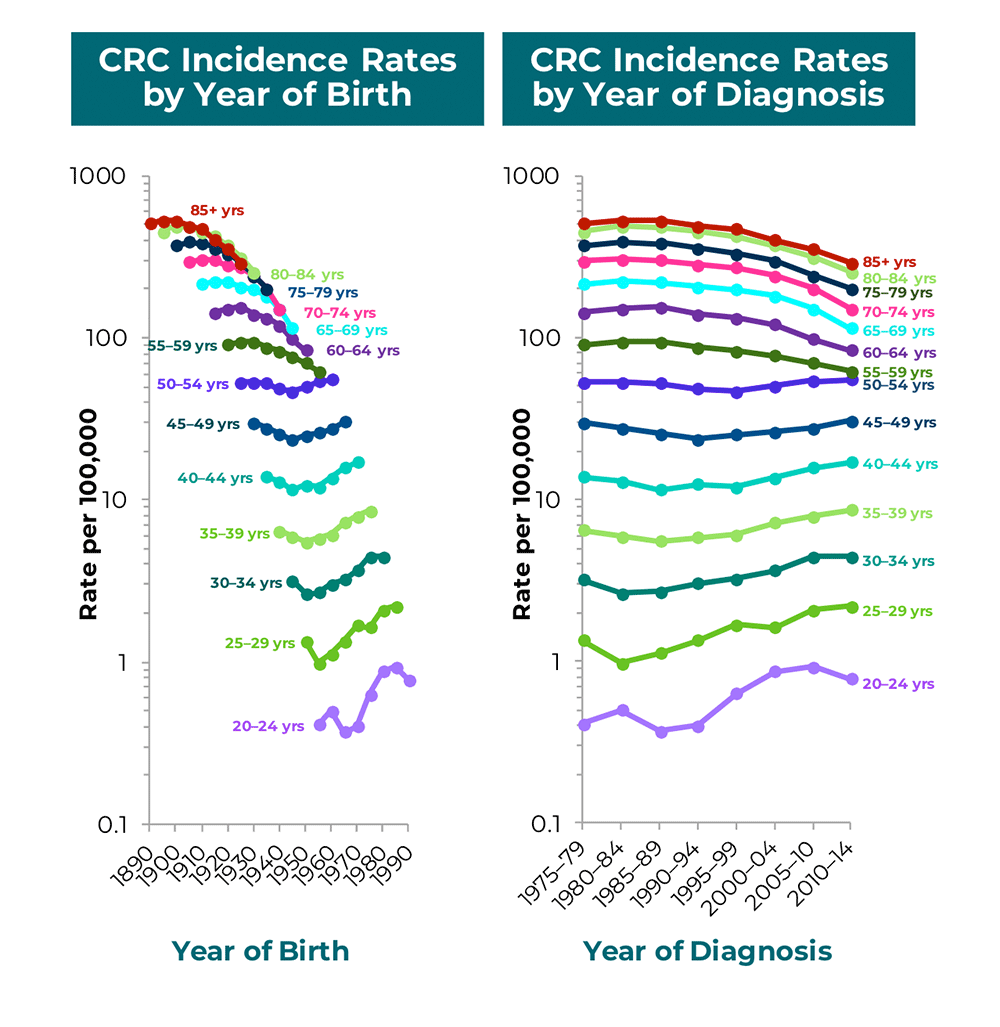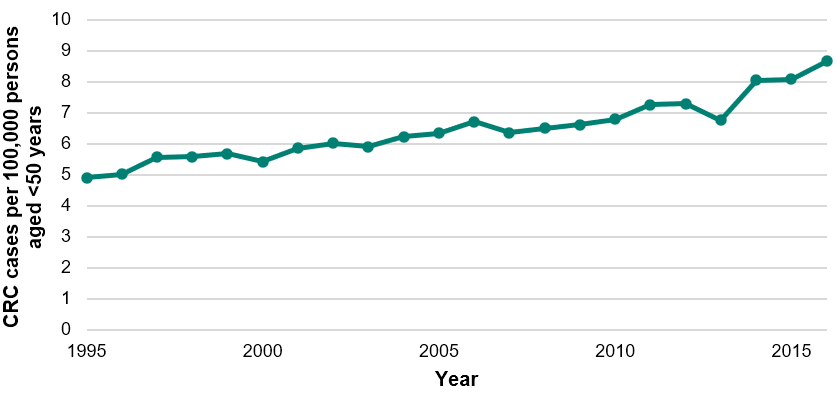Due potentially to changes in risk factors associated with lifestyle, environment, and metabolic influences, incidence of colorectal cancer (CRC) is rising in a younger population.1 In adults with CRC who are less than 50 years of age, a higher proportion present with primary tumors located in the distal colon and rectum.2 This age group has the highest proportion (~30%) of diagnoses with distant stage CRC,3 which is associated with the lowest 5-year survival rate.4
TRENDS IN COLORECTAL CANCER INCIDENCE RATES BY AGE AND YEAR OF BIRTH, AND BY AGE AND YEAR OF DIAGNOSIS, US, 1975 TO 20147

- Younger-birth cohorts carry an elevated risk of developing CRC with age7
- Incidence rates for colon cancer began increasing in the mid-1990s for adults aged 40–49 (1.3%/year) and is >2x the rate for adults aged 50–54 years (0.5%/year)7
- A 2.3%/year increase in rectal cancer incidence rates began in the 1990s in adults 40–54 years8
- A retrospective cohort analysis of SEER data from 1974-2013 found that adults born ~1990 have 2x the risk of colon cancer and 4x the risk of rectal cancer compared with adults born ~1950, who have the lowest risk8
POTENTIAL CONTRIBUTING FACTORS TO ONSET BEFORE AGE 501

- Approximately 16% of CRC in patients younger than 50 years is associated with a germline genetic predisposition to cancer; another 20-25% of cases are associated with family history of CRC, and the remaining cases are sporadic1
- Early-onset CRC in adults <50 years is associated with primary tumors in the distal colon or rectum compared to older populations in whom proximal colon tumors predominate2
- Learn more about pathobiology in younger patients with CRC
DELAY-ADJUSTED CRC INCIDENCE RATE, AGES <50 YEARS, 1995-20161,b

COLORECTAL CANCER INCIDENCE RATES PER 100,000 POPULATION IN 1-YEAR AGE INCREMENTS IN THE US SURVEILLANCE, EPIDEMIOLOGY, AND END RESULTS 18 REGISTRIES AMONG PATIENTS AGED 30 TO 60 YEARS, 2000–201510,e

- 46.1% increase in the incidence of CRC in the SEER 18 registries were found from 49 to 50 years of age10
- The study investigators interpreted this one-year jump as most likely indicating cancers that began before age 50 but went undetected due to the absence of screening prior to that age10
- 8799 of the 9474 cases (92.9%) of CRC in the SEER 18 registries from 2000 to 2015 that were diagnosed among individuals aged 50 years were invasive10
References
1 Patel SG, Boland CR. Colorectal cancer in persons under age 50: seeking causes and solutions. Gastrointestin Endosc Clin N Am. 2020;30:441-455.
2 Stoffel EM, Murphy CC. Epidemiology and mechanisms of the increasing incidence of colon and rectal cancers in young adults. Gastroenterol. 2020;158:341–353.
3 Siegel RL, Miller KD, Wagle NS, et al. Colorectal cancer statistics. CA Cancer J Clin. 2023;73(3):233-254.
4 American Cancer Society. Colorectal Cancer Facts & Figures 2023-2025. Atlanta: American Cancer Society; 2023.
5 Bailey CE; Hu CY; You, YN, et al. Increasing disparities in age-related incidence of colon and rectal cancer in the United States, 1975-2010. JAMA Surg. 2015;150(1):17-22.
6 Davidson KW, Barry MJ, Mangione CM, et al. Screening for colorectal cancer: US Preventive Services Task Force recommendation statement. JAMA. 2021;325(19):1965-1977.
7 Wolf AMD, Fontham ETH, Church TR, et al. Colorectal cancer screening for average-risk adults: 2018 guideline update from the American Cancer Society. CA Cancer J Clin. 2018;68(4):250-281.
8 Siegel RL, Fedewa SA, Anderson WF, et al. Colorectal cancer incidence patterns in the United States, 1974-2013. J Natl Cancer Inst. 2017;109(8).
9 Virostko J, Capasso A, Yankeelov TE, et al. Recent trends in the age at diagnosis of colorectal cancer in the US National Cancer Data Base, 2004-2015. Cancer. 2019;125(21):3828-3835.
10 Abualkhair WH, Zhou M, Ahnen D, et al. Trends in incidence of early-onset colorectal cancer in the United States among those approaching screening age. JAMA Netw Open. 2020;3(1):e1920407.
Footnotes
a The USPSTF concludes with moderate certainty that screening for CRC in adults aged 45 to 49 years has moderate net benefit (Grade B).
b Rates are adjusted for delays in reporting and are plotted as average rates of change over several years.
c Stage III/IV; vs 40.0% for those 50 years or older.
d Includes diabetes/metabolic syndrome, obesity, smoking, moderate alcohol consumption, red meats and processed meats.
e Increase in incidence rate at age 50 is confounded by the recommendation to begin average risk of screening at this age.
Last Updated: 06/04/2023